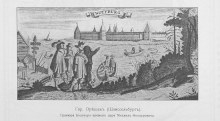Siege of Oreshek (1611–1612)
The siege of Oreshek (1611–1612) was the Swedish capture of the fortress of Oreshek after an eight-month siege during the Ingrian War of 1610–1617.
| Siege of Oreshek | |||||||
|---|---|---|---|---|---|---|---|
| Part of Ingrian War | |||||||
 Nöteborg Fortress in an engraving by Moritz Bodenehr | |||||||
| |||||||
| Belligerents | |||||||
|
|
| ||||||
| Commanders and leaders | |||||||
|
Evert Horn Claës Ericsson Slang | Venedikt Khomutov | ||||||
| Strength | |||||||
| 5,000 | 1,300 | ||||||
| Casualties and losses | |||||||
| Unknown | 1,200 dead | ||||||
Background
By the end of 1611, the Swedes, taking advantage of the difficult situation of Russia in connection with the Polish-Lithuanian intervention captured most of the Novgorod land including the fortresses of Korela, Yam and Ivangorod. After the capture of Novgorod in 1611, it was garrisoned by troops under the command of Jacob De la Gardie.[1]
The first attempt to take Oreshek took place in February 1611, when De la Gardie ordered the fortress to be stormed, blowing up two front gates with explosives. However, the third iron gate, according to Johan Widekindi, proved too tough for the attackers and they retreated after losing 20 men.[2]
Siege
The second attempt began in September 1611, when the Swedes, having captured Ladoga, again sent significant forces to Oreshek and blocked its approaches, seeking to starve it out. The new commander of the siege, the future Field Marshal Evert Horn, after November 30, offered the besieged "good terms" for surrender. The townspeople were required to submit to the royal governor and accept the Swedish garrison.[3] The archers defending the fortress refused to discuss its surrender.[4] Oreshkovites used a secret harbor to sortie out on boats and attack the Swedes. By April 1612 food shortages had made the situation critical. Hunger set in and disease began to rage.[5] According to Widekindi, out of 1,300 defenders some 100 remained, and on 12 May the fortress capitulated.[6]
Aftermath
The Swedes occupied the fortress and refortified it. The city was renamed Nöteborg and remained in the hands of the Swedes until 1702, when Peter the Great took the fortress and renamed it Shlisselburg.
References
- THE ROUTLEDGE ATLAS OF RUSSIAN HISTORY (PDF). Vol. 4. Routledge. p. 19.
- Ago, Katherinalivein #travel • 5 Years (2018-06-01). "Fortress Shlisselburg (Fortress Oreshek). Neighborhoods of St. Petersburg". Steemit. Retrieved 2022-12-16.
- "История крепости Орешек (Шлиссельбург) | Наша молодежь" (in Russian). Retrieved 2023-02-16.
- Talvite, Petri (2021). Civilians and Military Supply in Early Modern Finland (3 ed.). Finland: University of Helsinki. p. 101.
- "Shlisselburg Fortress, Shlisselburg, Russia - SpottingHistory.com". www.spottinghistory.com. Retrieved 2023-02-16.
- "Johannes Widekindi and the Origins of his Work on a Swedish-Russian War" (PDF). Lund University. 1 (1): 43.
Bibliography
- A. N. Kirpichnikov, V. M. Savkov. Fortress Oreshek. 2nd edition. Lenizdat, 1979